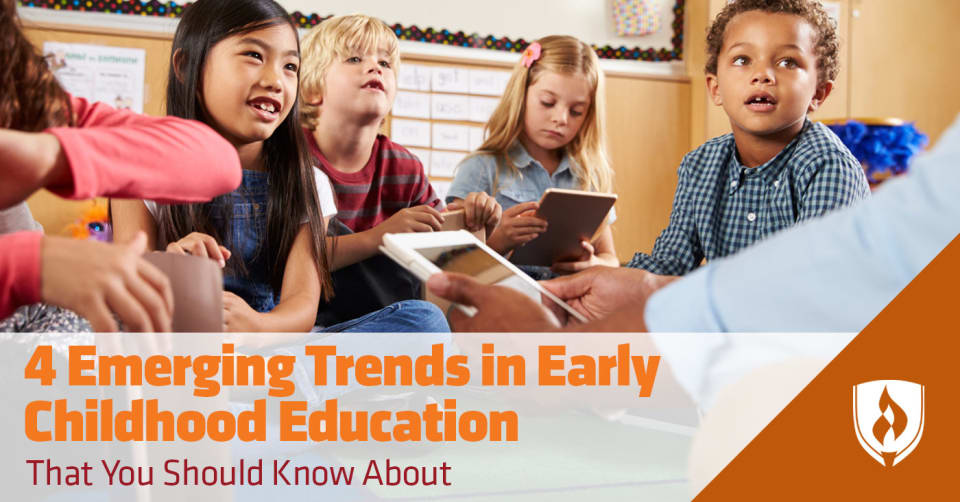
Issues in early childhood education (ECE) are issues you want to know about. Whether you parent, teach or just simply care about young learners, keeping an eye on the changes and trends in ECE is a great way to nurture the little ones in your life.
Even seeing what ECE experts are thinking about can be so inspiring. The one thing we know for sure about early childhood development is that there’s always more to discover. Many studies have concluded that, when done right, ECE provides lasting benefits to all students and has a major impact on our lives throughout adulthood.
But knowing ECE matters immensely doesn’t always mean we know how to best guide those brilliant young minds. This is why trends in early childhood education are so important. It’s how we find new ways forward. Explore the Pros and Cons of Universal Pre-K to gain insights into the potential benefits and drawbacks of implementing universal pre-K programs in early childhood education.
4 Trends in early childhood education to watch for
You don't have to spend hours watching education documentaries or scouring the internet to keep up with trends in the field. We asked ECE experts to weigh in on some of the trends they are noticing in early childhood education today—as well as what might be on the horizon.
1. A new focus on phonics in literacy instruction
“A trend I’m observing—and cheering for—in the field of early childhood education is the focus upon explicit, systematic phonics in literacy instruction,” says Dr. Christina Williams, owner of Book Bums. “In the past two years, more experts and more literacy-focused community groups are acknowledging that big publishing companies have been promoting inadequate curriculum.”
Williams explains that research findings have long shown a gap in how ECE materials and educators teach our code-based language to young learners. “One of the reasons for the trend toward phonics instruction is the reporting of Emily Hanford,” she explains.
Much of Hanford’s research centers on the unquestioned assumptions educators and educational materials have about teaching reading. With ECE experts re-examining phonics instruction, Williams sees changes coming not only for young learners—but also for educators.
How does it affect early childhood education?
“I have seen far too many teachers who haven’t the slightest idea how to teach kids to read and spell well,” Williams says. She explains that the trouble begins in universities not teaching teachers to understand phonics instruction. “Often, student teachers do not adequately understand how words work, themselves. When they secure their jobs, these young teachers rely on district-purchased curriculum to guide them, but far too often those materials use debunked methods that leave far too many readers behind.”
For ECE teachers, this gap leaves lots of room to stand out. Chris Drew, a university instructor in early childhood education, has also noticed many ECE professionals working without strong skill or knowledge in phonics methods. “I’m always impressed by a new staff member who really has a good grasp on teaching literacy. If you want to stand out for future employers, read up on how to teach phonics and demonstrate your competency with phonics in your job interview.”
Since learning to read is connected to success in school and in most of life thereafter—changing this paradigm is a high priority for ECE experts. “Far too many of our students struggle to learn to read, and far too many of them end up in our criminal justice systems,” Williams says. “I am observing that the trend is changing, and I’m so grateful.”
2. Educating with nature
“Scandinavian approaches like the ‘Forest Schools’ movement are starting to have an impact in North American ECE settings,” Drew says. It’s no wonder. Who wouldn’t be interested in trying to bring some of that light, greenery and fresh air into a school day?
But Drew points out that the trend is more than a surface appreciation of nature. “These sorts of spaces are great sandpits for development—children learn about natural environments, develop fine and gross motor skills, and build a connection to their local ecosystem.”
How does it affect early childhood education?
While Forest Schools themselves are becoming more popular—the natural space they require is out of reach for many schools. But the trend of teaching through nature could also show up in other ways, such as teachers making a conscious effort in incorporate natural elements into the classroom or dedicating time for outdoor exploration and play.
3. Closing the achievement gap under ESSA
The achievement gap refers to the differences in academic achievement of different social and economic groups. This is measured through a variety of metrics, including grade point averages, standardized test scores, dropout rates, college enrollment and college graduation metrics. The gap is measured between low-income and high-income households, white and minority students, males and females, students whose first language is English and students for whom English is a second (or third) language, among other factors.
The achievement gap is often used to determine funding for ECE. When the Every Student Succeeds Act (ESSA) passed in 2015, states gained the opportunity to evaluate their ECE needs and request grants from the federal government. These grants are then used to fund targeted programs designed to help improve literacy and other important academic skills for those involved.
How does it affect early childhood education?
Assessment of student learning is a crucial element of a successful education, as it can help educators identify learning needs early on. But it is also one of the primary metrics schools have to determine if they are succeeding with their young learners.
Early education centers with disadvantaged students—such as children from low-income families, foster children or children who are learning English as a second language—may gain more funding from the state when they can prove academic progress with these students is closing the achievement gap.
For those working in early education, this might mean more ongoing education, formal assessments and new state-wide initiatives. Check out Understanding ESSA to read about the impacts in your state.
4. Technology in child development
Technology is an ongoing trend in ECE—as it is in pretty much every industry. It’s a constant balance for ECE experts to decide how to teach with technology, while also teaching digital resilience as they know children are likely to interact with devices at home.
Like it or not, technology and device usage by young children is a fact of life for large number of children. Children are owning devices and using the internet at a young age—and are spending much more time in front of small screens.
How does it affect early childhood education?
Discovering resources that meet the needs of students can greatly enrich the current material they are learning. Even with the proven effectiveness of technology in the classroom, educators are left with a few questions: What role should technology play in our classrooms? What should we teach our students about using technology?
One of the most important elements to consider is how children are interacting with the technology, ensuring that new tools are developing positive behavior. Technology—or screen time—also comes in many forms. According to the Common Sense Census, these are the four main forms:
- Passive consumption: Watching TV, reading and listening to music
- Interactive consumption: Playing games and browsing the Internet
- Communication: Video-chatting and using social media
- Content creation: Using devices to make digital art or music
When it comes to the question of how much technology to incorporate into lesson plans, Common Sense Media recommends no more than one hour per day.
A trend of society recognizing the importance of ECE
“There is an increasing awareness that the early years are the most vital years of life,” Drew says. While early childhood educators and psychologists have been talking about this for a long time—public awareness, as well as laws and the funding around early education has been lagging.
“Expect to see increasing investment in ECE in the coming decade as states and nations realize early support for children delivers big rewards down the track.”
An important characteristic of the most effective ECE professionals is the commitment to always continue educating themselves regarding the trends, changes, studies and conversations in the industry. Armed with these three trends in early childhood education, you may find yourself better prepared to help your students succeed.
You can even help the people around you understand why early childhood education matters so very much. See our article, “5 Reasons Why the Importance of ECE Is Impossible to Ignore,” for an inspiring breakdown on why we care so much about our little learners!
The Early Childhood Education programs at Rasmussen College are not accredited by the NAEYC Commission on Early Childhood Associate Degree Accreditation. Rasmussen College is not a partner of NAEYC and our programs are not sponsored or endorsed by NAEYC.
Graduates of Early Childhood Education programs at Rasmussen College are not eligible for licensure as a teacher in an elementary or secondary school. A Bachelor’s degree and a state teaching license are typically required to work as a teacher in a public school and some private school settings. States, municipalities, districts or individual schools may have more stringent licensing requirements. Students must determine the licensure requirements in the state and school in which they intend to work.
Childcare facilities and the states in which they are located establish qualifications for staff who work with children, and often implement guidelines regarding age, education, experience and professional development. Students must determine the licensure requirements for the state and facilities in which they work.
This program has not been approved by any state professional licensing body, and this program is not intended to lead to any state-issued professional license. For further information on professional licensing requirements, please contact the appropriate board or agency in your state of residence.




